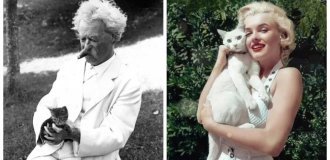May the honorable public forgive me, many may not like this, but today I want to continue the topic of sweets in the USSR, which I started yesterday with cakes. Today's one will be dedicated to chocolate and candies.
It will be difficult to talk about all brands of sweets and chocolate. We will talk about the most popular at that time.

The history of the appearance of chocolate and sweets in Russia and the USSR.
It seems to us now that chocolate has always been around. Well, it’s impossible to imagine that there was once no chocolate candy in this world. Meanwhile, the first chocolate bar appeared only in 1899 in Switzerland. In Russia, confectionery production until the beginning of the 19th century was, for the most part, artisanal. Foreigners were also actively exploring the Russian confectionery market. The history of the appearance of chocolate in Russia began in 1850, when Ferdinand von Einem, who came from German Württenberg to Moscow, opened a small workshop on Arbat for the production of chocolate products, including sweets.

In 1867, Einem and his partner Geis built a new factory on the Sofiyskaya embankment. According to information from the history of chocolate in Russia, this factory was one of the first to be equipped with a steam engine, which allowed the company to quickly become one of the largest confectionery manufacturers in the country.

After the revolution of 1917, all confectionery factories passed into the hands of the state - in November 1918, the Council of People's Commissars issued a decree on the nationalization of the confectionery industry. Naturally, the change of owners entailed a change of names. The Abrikosovs' factory was named after worker Pyotr Akimovich Babaev, chairman of the Sokolniki District Executive Committee of Moscow. The Einem company became known as “Red October”, and the former factory of the Lenov merchants was renamed “Rot Front”. True, the ideas of Marx and Lenin, the revolutionary spirit and new names could not in any way influence the technology of confectionery production. Both under the old and new governments, sugar was needed to produce sweets, and cocoa beans were needed to make chocolate. And there were serious problems with this. The “sugar” regions of the country were under the rule of the whites for a long time, and the currency and gold, for which it was possible to buy overseas raw materials, were used to purchase bread. Only by the mid-20s was confectionery production more or less revived. The NEP helped this; entrepreneurial spirit and the growing well-being of city residents made it possible to quickly increase the production of caramel, sweets, cookies, and cakes. The planned economy that replaced the NEP left its mark on the confectionery industry. Since 1928, the production of sweets was strictly regulated, each factory was transferred to its own, separate type of product. In Moscow, for example, caramel was produced by the Babaev factory. The producer of chocolate in the USSR was the Red October factory, and the producer of cookies was Bolshevik.

During the war, many confectionery factories were evacuated from the European part of the country to the rear. Confectioners continued to work, producing, among other things, strategically important products. The “emergency supply” set necessarily included a chocolate bar, which saved the lives of more than one pilot or sailor.
After the reparation war, equipment from German confectionery enterprises arrived from Germany to the USSR, which made it possible to quickly establish the production of chocolate products. Chocolate production grew every year. For example, in 1946, the Babaev chocolate manufacturing company in the USSR processed 500 tons of cocoa beans, in 1950 - 2000 tons, and by the end of the 60s - 9000 tons annually. This impressive growth in production was indirectly facilitated by foreign policy. For many years, the Soviet Union supported various regimes in many countries of the world, including African ones. The main thing for these regimes was to swear allegiance to communist ideals, and then assistance in the form of weapons, technology, and equipment was provided. This support was practically free of charge; the only thing Africans could somehow pay back to the USSR with was raw materials and agricultural products. That is why confectionery factories were uninterruptedly supplied with raw materials from distant African expanses.
In those years, there was no competition between chocolate producers in the Soviet Union, in the traditional sense. Confectioners could compete for awards and titles, for example, “best in the industry,” for awards at exhibitions, for the love, in the end, of consumers, but not for their wallets. Very careless and “tasteless” manufacturers could have problems with the sale of candy and other sweet products. But there was no shortage, at least in large cities. Of course, from time to time the names of candies in the USSR, such as “Belochka”, “Mishka in the North” or “Karakum” disappeared from the shelves, and “Bird's Milk” rarely appeared on them, but usually Muscovites, Kievites or Kharkovites could buy, even Not every store has its own favorite delicacies. The exception was pre-holiday days. Every pre-New Year children's performance in the theater or matinee ended with the distribution of sweet sets, which is why the most popular varieties of sweets disappeared from store shelves at that time. Before March 8, it was difficult to find sweets in boxes, which, together with a bouquet of flowers, made up a “universal” gift for the holiday that did not require serious thought from men.
Candies "Squirrel"
Chocolate candies, the main attribute of which is crushed hazelnuts in the filling, as well as a stylized image of a squirrel with a nut in its paws.
The first “Squirrel” appeared in the early 1940s and was produced by the N.K. Krupskaya Confectionery Factory, which was part of the Leningrad Production Association of the Confectionery Industry. During Soviet times, the factory's production volume of these popular sweets reached thousands of tons per year.

Candies "Karakum"
Chocolates were made from nut praline with the addition of cocoa and crushed wafers.
Initially, “Kara-Kum” was a brand name of the Taganrog confectionery factory.

Candies "Bear in the North"
Soft glazed candies with nut filling enclosed in a wafer body, affectionately called “Bear in the North”, by the confectioners of the factory named after. Krupskaya began to be produced on the eve of the Great Patriotic War, back in 1939. The residents of the city on the Neva loved the candies so much that even during the most difficult period in the life of Leningrad, despite all the difficulties of wartime and the state of siege, the factory did not stop producing this delicacy and already in 1943 produced 4.4 tons of “Mishka in the North” sweets. And who knows, maybe “Bear in the North” became one of those important elements that supported the residents of the besieged city’s faith in victory.

Candies "Teddy Bear"
“Bear-toed Bear” is a kind of Soviet confectionery symbol - it comes not from the USSR, but from Tsarist Russia. Its history began in the workshops of the “Partnership of the Steam Factory of Chocolate, Sweets and Tea Cookies “Einem””, and the history of the creation of the candy itself has long been overgrown with numerous legends.
Around the 80s of the 19th century, Julius Geis, the head of the Einem Partnership, was brought a candy for testing: a thick layer of almond praline was enclosed between two wafer plates and glazed chocolate. The manufacturer liked the confectioners' find, and the name immediately appeared - “Bear-toed Bear”. According to legend, a reproduction of the painting “Morning in a Pine Forest” by Ivan Shishkin and Konstantin Savitsky hung in Geis’s office, as a result of which the name and later the design of the new delicacy were first invented.

Candies "Red Poppy"
Chocolate-coated candies, body - praline with the addition of candy crumbs and vanilla and hazelnut flavors.
Presumably the name of the candy comes from the ballet “The Red Poppy”. In 1926, the Bolshoi Theater was preparing to stage a new ballet, “The Daughter of the Port,” but the theater management considered the libretto of Reinhold Gliere’s ballet to be insufficiently dynamic and not very interesting. The director and artist revived the plot, and the musical design of the ballet "Daughter of the Port", with the permission of the author, was transferred to the musical design of the ballet "Red Poppy".
The storyline also includes negative characters in the form of conspirators and the treacherous port master Khips, Soviet sailors, and a young Chinese woman named Tao Hoa, who is in love with the Captain of the Russian ship. The conflict between the bourgeoisie and the Bolsheviks, the attempt to poison the just Captain and the tragic death of a brave girl! In the final scene, representatives of the Chinese poor - the Red Peaks partisans - carry the body of a mortally wounded girl on a stretcher, covering her with a red banner. Having woken up, the dying Tao Hoa gives the surrounding children a scarlet poppy flower, donated by the Captain. A huge red flower lights up in the sky. The poor, freed from the power of Europeans, come to him. Countless red poppy petals are poured onto the stretcher with the dead Tao Hoa. A sad and at the same time beautiful story, isn’t it worthy of perpetuation in the art of confectionery?

Candy "Come on, take it away!"
Candies with a praline body, glazed with chocolate glaze.
The candy “Come on, take it away!”, popular in Soviet times. was also released more than a hundred years ago at the Einem factory thanks to the artist Manuil Andreev. On the candy wrapper he depicted a fierce-looking boy with a bat in one hand and a bitten Einem chocolate bar in the other. There was no doubt that the boy was ready to do anything to finish his chocolate.
In this form, the candy did not last long, since a happy Soviet baby could not have such a fierce look, especially with patched pants. Therefore, on subsequent versions of the label of the factories of the USSR Narkompishcheprom, and after 1947 - the Ministry of Food Industry - the boy smiles happily, his hand is already in his pocket and the stick has disappeared. The name also changed slightly - the hyphen was rearranged in places and the word “candy” was replaced with the familiar “candy”.
In 1952, Andreev’s student, artist from the Red October factory, Leonid Chelnokov, creatively reworked and preserved the background of the wrapper, and painted a girl in a blue polka dot dress with candy in her hand and a white dog. The inscription has already been made according to all the rules of modern spelling.

Caramel "Cancer necks"
Caramel in the form of pillows with chocolate and nut filling made from roasted almonds and cocoa.
These candies, and together with them “Crow’s Feet” and “Duck’s Nose”, were the signature product of Alexey Abrikosov’s confectionery factories. After the nationalization of the factory, the popular sweets retained not only the original recipe, but also the name.
The name of the caramel is associated with the external similarity of the shape of the candy to boiled crayfish tails.

Bars "Rot Front"
Chocolate bar with crushed wafers and grated peanuts.
The Rot Front factory dates back to 1826, when an enterprising tradesman Sergei Lenov opened a “Confectionery Workshop” for the production of fudge and caramel in the Zamoskvorechye region. Soon the company's products became very popular and received recognition from buyers and merchants throughout Russia, and the small workshop grew into a large factory of the G.A. Trading House. and E.S. Lenov."
In 1917, the owners of the factory, the Lenov family, sold it to the Central Union. The enterprise receives a new name - “Confectionery Factory of the Moscow Union of Consumer Societies”. At the end of 1918, the factory, like many other enterprises, was nationalized. The name "ROT FRONT" appeared in 1931 as a sign of solidarity with German anti-fascist workers (the words "Rot Front" (Red Front) were the motto of the German mass organization of anti-fascist workers).

Iris "Kis-Kis"
Fondant mass obtained by boiling condensed milk with sugar, molasses (molasses) and fat (butter or vegetable oil or margarine).
In Soviet times, along with "Kis-Kis", the iris "Golden Key" was also very popular.
It is believed that the name “iris” was given to a batch of milk sweets by the French confectioner Morna, or Mornas, who worked in St. Petersburg at the beginning of the 20th century, who noticed the similarity of their relief with iris petals.

Candy caramel "Monpensier".
In the Soviet Union, the most popular sweets were lollipops in iron cans (monpensiers). Fruit lollipops, small, like tablets. Real candies, made from caramelized sugar.
Tastes, like colors, were different. Some purposefully bought, for example, only lemon, orange or berry ones, while the majority chose assorted ones.

Chocolate "Inspiration"
It was the first chocolate in the country, divided into portioned pieces. Few people know, but we owe its appearance in our country to the Chairman of the Council of Ministers of the USSR Alexei Kosygin. During his visit to France, local confectioners treated him to something similar.
Inspired, Kosygin brought French chocolate with him and gave instructions to State Confectionery Factory No. 2 to immediately begin its own production. In 1967, chocolate called “Inspiration” appeared on the shelves. For the packaging design, the theme of ballet was chosen, which has always been the hallmark of our country.

Chocolate "Alenka"
Milk chocolate produced in the USSR since 1965.
In the early 1960s, the USSR government adopted a new food program, in which special attention was paid to the creation of mass-produced, affordable milk chocolate. At various factories in Moscow, experiments began to create delicious chocolate. In 1964, Soviet confectionery specialists at the Moscow Red October factory developed a suitable recipe, which was introduced into production simultaneously with Red October at the Rot Front and im. Babaev, and then at many other Soviet confectionery factories. The first “Alyonkas” were Babaevskaya - a girl in a blue headscarf - and two Rot-Front ones - a girl with a watering can and a girl with a dog and a bunny. The chocolate got its name after Valentina Tereshkova’s daughter Elena.
Until 1964, Alyonka, produced by Red October, did not have a permanent wrapper design. At first, chocolates were produced with different images and different wrapper colors. As a result, the factory decided to develop its own signature portrait of “Alyonka”. It was proposed to use Vasnetsov’s painting “Alyonushka” in the cover design, but this idea did not receive support. And then the factory management, through the newspaper “Evening Moscow”, announced a competition for a photograph of a girl, which would later become the theme for the design of the chocolate bar. The competition was won by the photograph of Honored Cultural Worker of the RSFSR Alexander Gerinas, which he took in 1960. The photo showed Gerinas' eight-month-old daughter Elena wearing a silk scarf.






















